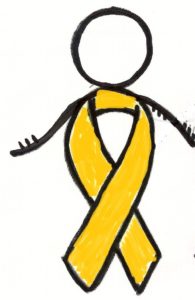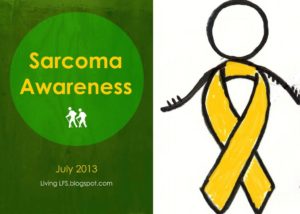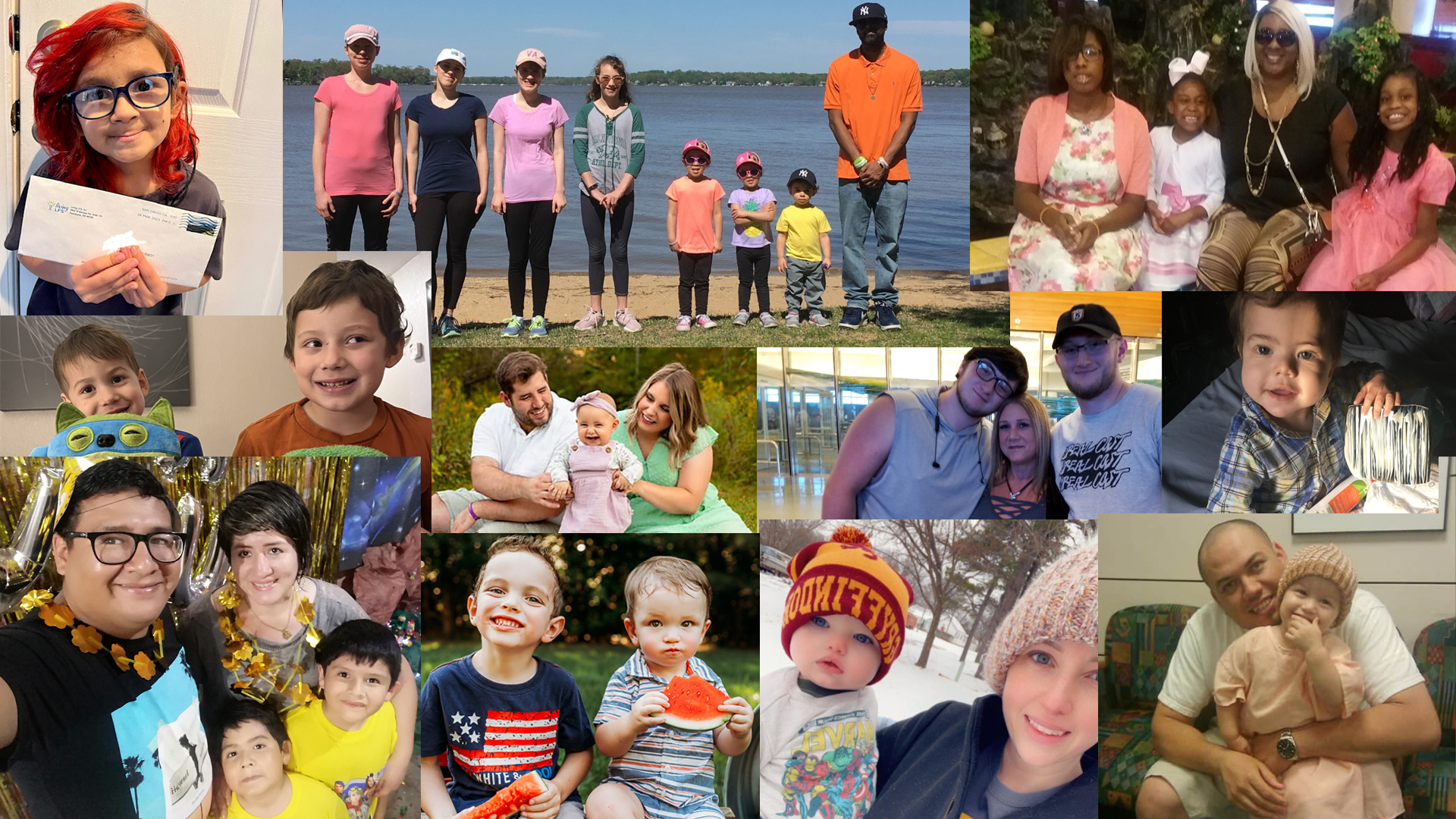July is Sarcoma Awareness Month and there is a LONG way to go on the road to awareness. Mere weeks after having a Fibrohistiocytic Tumor removed from my arm- I was registering at a major cancer center and the lady behind the desk gasped and asked What happened? I told her it was a sarcoma and she looked at me like I had just arrived from Mars, What's that? While I don't expect a person behind the registration desk at a major cancer center to be able to diagnose, treat, or recognize all types of cancers- this does illuminate how far we have to go in the world of awareness for sarcomas.
Many sarcomas are listed by where they are found or the cell type- Rhabdomyosarcoma(striated muscle), Liposarcoma(fatty tissue- often mistaken for cysts), Leiomyosarcoma(smooth muscle), Osteosarcoma(bone), chondrosarcoma(cartilage) You may have had or known someone with a sarcoma if you recognize the terms: Malignant Fibrohistiocytoma, Myxoma, or Gastrointestinal Stromal Tumor- also sarcomas.
Sarcomas are considered rare- which is to say they make up less than 1% of all cancers. Sarcomas are not so rare as one of the top four LFS cancers, a CORE tumor type- but everything, including rarity is relative in a rare cancer syndrome. Unlike most other tumor types- sarcoma is not limited to one region of the body. This is partially what makes sarcomas so difficult to recognize or screen for. They can be hard, soft, painful, pain-free, slow growing or really aggressive. You can find sarcomas in bones, muscles, fat, or connective tissue(blood vessels, nerves,cartilage). They can appear at any age. In a 2009 study of LFS and germline p53 mutations by Kelly Gonzalez, et. al, among 596 suspected Li Fraumeni patients, 82 patients had germline mutations(141 tumors) and 38 of their tumors were sarcomas- that's 27% of the tumors. The sarcomas appeared anywhere from age 2 to 59 with the average age being 26 for females and from ages 1 to 46 for males, average age 20. Due to this link between Sarcomas and Li Fraumeni Syndrome, by 2012 specialists at Dana Farber began recommending that all children diagnosed with sarcoma undergo genetic counseling and testing.
So, it is established that in the world of Living with LFS- sarcomas are definitely something to watch out for. Most of us know this through personal experience. What do we need to look out for and what can we do about it?
PREVENTION
-Avoid Ionizing Radiation.
There is a definite link between radiation and sarcomas. A study published in the journal Carcinogenesis in 2006 discussed how TP53 is especially sensitive to mutations caused by radiation. In the Li Fraumeni Syndrome Workshop in 2009, Dr. Gareth Evans discussed several cases where sarcomas or other malignancies were found in tumor beds of LFS patients who had radiation treatments.
Radiation is all around us and you can't always see it to jump out of the way, so what's a mutant to do? Avoid radiation where possible. There are plenty of studies supporting and refuting that electronics may or may not cause cancer. Technology surrounds us- wires, cell phones, microwaves, background radiation from power plants or the sun. If you know you are at risk for damage by mutation- take precautions where you can. There are only so many things you can control- it's important to only focus on the ones you absolutely can. Sunscreen protects the skin from the sun's rays- so do long sleeve shirts or umbrellas. Have you ever talked on a cell phone while it heats up? You can use headphones to talk on a cellphone if you are worried or place a pad between you and your laptop. All we can do is make the best choices we can to live healthy lives.
Make sure doctors are aware of your mutant status and the radiation sensitivity, always ask if the least damaging option for screening is being used. MRIs and Ultrasounds can be used in many cases over CT scans or Xrays. It is important to keep these lines of communication open with your medical team and feel comfortable with your options. You can always refuse a scan if you are worried about radiation exposure but sometimes a CT or PET scan might give the medical team the best information to help you. In cases of treatment with radiation for existing cancers- it's important to weigh the risks and benefits of each procedure and what is ok with you as well as what is recommended by your professional staff. Sometimes radiation treatments are the best bet at potentially curing an existing cancer, even in a mutant and that is well worth consideration. Like the rarity of the syndrome and many of the cancers it presents- every case is unique and there is no one size fits all screening or treatment!
-Avoid Chemicals and Dioxins
As with radiation, chemicals and toxins are all around us. We do have a choice though in how we handle them. Since sarcomas are rare- there is not a lot of information on causes- but there are some risk factors- like having LFS or being around chemicals like vinyl chlorides(used to make plastics), certain herbicides, and dioxins(a by product of burning chemicals and smoking- can be released by fires or contaminate groundwater). Small changes like not heating up plastics could have a positive impact for people with LFS. If you use herbicides- make sure you are protected when handling them.
DIAGNOSIS
-Pay attention to lumps and bumps
If a lumps or bump persists for more than a week or two- has no pain or any known injury associated with it- it's worth monitoring or having checked out by a doctor who knows your medical history. Some sarcomas, like Fibrohistiocytic tumors are slow growing but have a tendency to metastasize to the lungs or brain, it's important to catch these early. Although biopsies are the only true way to know for sure the pathology of a lesion- ultrasounds and MRIs are other noninvasive screening tools that might be used to rule out cysts or other benign causes of lumpiness. Sometimes scar tissue can build up under the skin, there are lots of non cancerous causes of bumps. Routine dental and physical check ups are a consistent way to keep a medical professional on your lump watch. The Toronto Protocol is designed to screen for main LFS cancers- the full body MRI is recommended annually as a way to proactively catch small sarcomas that can't be felt. The Toronto Protocol also recommends bi annual physicals.
-Trust your Gut
If you have an ache or pain that doesn't seem to go away and no good cause for it- have it checked out. If you have an injury that just doesn't seem to heal after weeks then months- have it looked at. Sometimes sarcomas hide behind nerves and when they get big enough or touch it- there is pain. Sometimes osteosarcomas weaken the bones causing minute fractures and pain. Anytime the body is fighting cancer- the immune system is compromised- bruises take longer to heal, cuts don't quite scab over as fast. Sometimes having a questionable spot checked out can be something easily explained and treated, then your mind is at ease and you can sleep better. It is stressful to worry that every little lump might be malignant- then again it might not be something you have to worry about at all.
-Good Pathology
Not only is Li Fraumeni Syndrome rare- a lot of the tumors we sprout are really, really rare. I guess like us- our tumors are one of a kind- or one in a gazillion. Having a trusted pathologist on staff is important. A good pathologist will send out samples to other specialists if he/she is uncertain. Tumor samples can often contain different types of cells- having several eyes looking at a tricky tumor is a good thing. The down side to this is that it can take time- and the waiting is really tough. A lot of times with fast growing tumors- time is of the essence- but good pathology can have a huge impact on the surgical margins and follow up treatment. Wide, clear surgical margins are always a good thing but sometimes unattainable due to tumor location- this is when a trusted pathology report is important.
Centers In the Know:
Having sarcoma can be scary enough- to have a p53 mutation on top adds several new considerations. Most of the known cancer centers have a good knowledge of sarcoma and LFS. Like any cancer, you have to go to the treatment center or provider that fits your lifestyle, schedule and financial considerations. Don't be afraid to call and ask for second opinions. Many good experts are happy to work with a local oncologist on your behalf. You don't have to be seen by an expert to get amazing treatment- so much of the journey is choosing the parts of the path you have control over. Listed below in no particular order are centers that have seen many LFS and Sarcoma cases. If you have been to one not on this list- send me a message- I'd be happy to add it as a resource for others. The Sarcoma Alliance site also has a pretty comprehensive list of Sarcoma specialists if none of these are near you!

Australian Sarcoma Group
Christie Hospital- Manchester UK
Cleveland Clinic
Dana Farber
Huntsman Clinic
Mayo Clinic
MD Anderson
Memorial Sloan Kettering
Stanford- CA
St. Jude's
Where to get more information on Sarcomas:
Sarcoma Alliance
Rein in Sarcoma
Resources
Sarcoma Alliance
Beyond Li Fraumeni Syndrome- Clinical Characteristics of Families with p53 Germline Mutations
Specific TP53 Mutation Pattern in Radiation Induced Sarcomas
Dana Farber Recommends Child Sarcoma Patients Have Genetic Testing
Dioxins
Toronto Protocol



